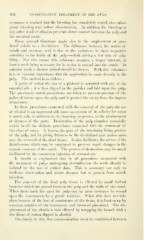Page 428 - My FlipBook
P. 428
426 CONSERVATIVE TREATMENT OF THE PULP.
assurance is reached that the bkn'ding has completely ceased, else subse-
quent bleeding may induce discoloration. In addition the bleeding or
any other kind of eflPusion prevents direct contact between the pulj) and
the arsenical paste.
These general directions apply also to the employment of pow-
dered cobalt as a devitalizer. The difference between the action of
cobalt and arsenous acid is due to the variations in their respective
solubility in the fluids of the pulp—cobalt having a low rate of solu-
bility. For this reason this substance requires a longer interval, at
least a week being necessary for its action to extend into the canals. In
anterior teeth a shorter period should be chosen. With this substance
it is of extreme importance that the application be made directly to the
pulp. The method is as follows :
A pellet of cotton the size of a pinhead is saturated -with any of the
essential oils ; it is then dipped in the powder and laid upon the pulp.
The previously stated precautions are taken to prevent pressure of the
pellet of cotton upon the pulp and to protect the cavity from the ingress
of moisture.
In these procedures connected with the removal of the pulp the use
of alcohol is an important aid, since on account of its affinity for water
it much aids, in addition to its cleansing properties, in the procurement
of dryness of the parts. Desiccation of the pulp chamber materially
assists in all the delicate procedures connected with the treatment of
this class of cases. It lessens the pain of the remaining living portion
of the pulp, and by giving firmness to the devitalized part makes more
easy the removal of the dead tissue. It also facilitates the action of the
disinfectants which may be employed to prevent rapid changes in the
organic contents of the canal. The process of desiccation may be much
facilitated by the concurrent injection of warmed air.
It should be emphasized that in all procedures connected with
the treatment of pulps undergoing devitalization the teeth should be
isolated by the use of rubber dam. This is necessary not only to
facilitate observation and secure dryness but to protect from mouth
infection.
The removal of the dead pulp tissue is effected by small barbed
broaches which are passed between the pulj) and the walls of the canal.
When these reach the apex the pulp may in most instances be wound
upon the instruments by a gentle rotation. When this does not take
place because of the loss of consistence of the tissue, it is broken up by
constant rotation of the instrument and removed piecemeal. The dis-
placement of the shreds is best effected by wrapping the broach with a
few fibers of cotton dipped in alcohol.
Previously to this, free communication must be established between


